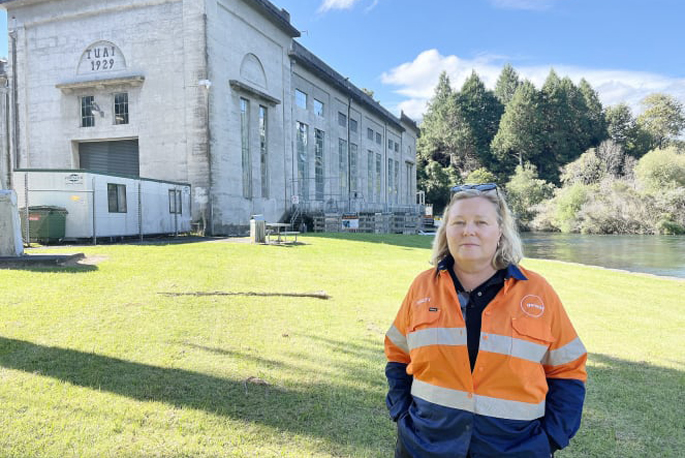Genesis energy company is sharing its experience of Cyclone Gabrielle following a media tour of the Lake Waikaremoana Power Stationl.
The company is keen to dispel rumours that they “opened the floodgates”, causing the flooding of Wairoa during the cyclone last year.
They also want to highlight the work being done to switch to renewable energy — in which the company aims to have invested $1 billion by 2030.
The team at Genesis Lake Waikaremoana power plant were proud of their efforts to keep the region running during the floods.
“We were the only real major generation working at the time,” saysa Genesis team member.
“Effectively, if you become stranded from the grid on the East Coast or the North Island, you’re relying on the generation from that area to power your own homes or businesses.”
“So the team here are really proud of what they’ve achieved,” says chief wholesale officer Tracey Hickman.
“Without the power station, the lights could have been out for the whole region for a long amount of time.”
Hickman points to the Onepoto intake structure and says, “as you can see, there aren’t any floodgates to open”.
After the cyclone, Genesis commissioned an independent review which found that their water was responsible for only 1 per cent of Wairoa’s flooding. The Wairoa District Council is conducting its own review of this data to verify the report.
The rest of the flooding was overflow from streams and rivers, Hickman says.
Before the cyclone, Genesis had seen the weather forecasts and intentionally lowered the lake by six per cent to reduce the possibility of overflow.
During the flood they had to flow the water according to the resource consent rate of between 35-40m³ per second.
Hickman says the resource constraint is there in case of uncertainty on whether there will be “lots more rain, or no rain — potentially you’re going to get a mixture of both”.
“It’s a balancing act, which is why we have minimum constraints and maximum constraints to try to manage rain.”
General manager for media and communications Chris Mirams says Lake Waikaremoana operates about 5.5m below the natural lake level, which enables flood flows to be stored rather than passed directly downstream.
A Genesis team member says: “Without the power scheme, there’d be no control of the lake water. So this scheme actually becomes a safety control point for the river flows.”
During the media tour, Genesis’s efforts to decarbonise New Zealand featured heavily.
Hickman, who has a Masters degree in environmental studies, says the electricity sector has an important part to play in decarbonising New Zealand.
“Genesis is investing really heavily in solar farms and, over time, in wind farms,” she says.
“One of the big constraints around solar and wind farms is, it’s great when the wind is blowing and when the sun is shining, but you need to diversify when that is not available.
“In New Zealand that’s hydropower schemes, but currently dry winters are a huge problem for us, when the rain does not come.
“So, we are planning a large grid scale battery at our Huntly site and these might increase in years to come because that provides intermittent grid firming, when the sun and the wind come and go.”
Hickman says Genesis is also exploring the possibility of biomass, which is the process of turning wood pallets into energy. Forestry slash could potentially be used for this, she says.
“Genesis still has the Huntly power station (which is run through coal and gas) and New Zealand depends on that power station when the hydro lakes are low.
“We’re all working really hard to see if we can just replace coal with something more renewable.
“The benefit of biomass is when you do not need it you are are able to store it.
“And then you have it available when the hydro lakes are low.”
LDR is local body journalism co-funded by RNZ and NZ On Air.




0 comments
Leave a Comment
You must be logged in to make a comment.